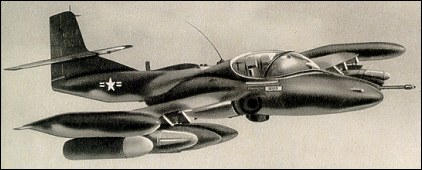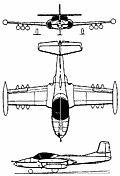 |
Cessna Model 318 / T-37 / A-37 Dragonfly1954 |  |
| TRAINER, LIGHT STRIKE AIRCRAFT | Virtual Aircraft Museum / USA / Cessna |
 |
In the early 1950s the US Air Force was looking for a turbojet-powered trainer, and in 1953 Cessna was announced winner of this design competition, two prototypes being ordered under the designation XT-37. The company identified the type as the Cessna Model 318, and the first of these made its initial flight on 12 October 1954. It was a perfectly straightforward monoplane of all-metal construction, with pupil and instructor seated in what had long been considered to be an ideal side-by-side arrangement (contrary to the normal US tandem practice). Powerplant consisted of two Continental turbojets (Americanised versions of the French Turbomeca Marbore) mounted within the wing roots on each side of the fuselage. The tail-plane was mounted above the fuselage about one-third of the way up the fin to ensure that the airstream flowing past it was unaffected by the jet efflux. The first production batch of 11 aircraft, which had the designation T-37A, was ordered during 1954, and the first of these flew on 27 September 1955. The T-37As, of which 534 were built under successive contracts, were slow in entering service as a result of the need for a number of changes and modifications before they were considered acceptable for training purposes. When introduced into service, in 1957, the T-37s were used initially as basic trainers, the pupils transferring to these aircraft only after completing their primary training on Beech T-34 Mentors. In April 1961 all-through jet training was initiated, the pupil flying from the very beginning of his training on T-37 aircraft which had a speed range of 138-684km/h. No catastrophic accident rate resulted, as had been feared by many, but one point which had not been fully considered was the much higher training cost using jet aircraft. There is inevitably a varying pupil rejection rate at the end of primary training, and it was decided in 1964 to revert to light piston-engine trainers, which are much cheaper to operate, for this primary phase, so that T-37 pupils were those left after the first weeding-out. The T-37B with more powerful engines and improved nav/com systems, was introduced into service in November 1959, and all surviving T-37 As were converted retrospectively to this standard. Final version was the T-37C with provision for armament and wingtip fuel tanks. When production ended in 1977 a total of 1,268 T-37s had been built for the USAF and for export. "During 1962 two Cessna T-37B trainers were evaluated by the USAF's Special Air Warfare Center to consider their suitability for deployment in the counter-insurgency (COIN) role. These were first tested with their original powerplant of two 465kg thrust Continental J69-T-25 turbojets, at a take-off weight of 3946kg, almost 33% above the normal maximum take-off weight. Subsequently the airframes were modified to accept two 1089kg thrust General Electric J85-GE-5 turbojets. This vast increase in power made it possible for the aircraft, then designated YAT-37D, to be flown at steadily increasing take-off weights until a safe upper limit of 6350kg was reached. There was, clearly, plenty of scope for the carriage of a worthwhile load of weapons. This exercise was academic, until the need of the war in Vietnam made the USAF take a closer look at this armed version of what had proved to be an excellent trainer. Accordingly, Cessna were requested to convert 39 T-37B trainers to a light-strike configuration, a contract being awarded in 1966: this related to the conversion of new T-37B aircraft taken from the production line. The new model was based on the earlier experiments with the two YAT-37Ds, and equipped with eight underwing hard-points, provided with wingtip tanks to increase fuel capacity and powered by derated General Electric J85-GE-5 turbojets. Delivery to the USAF began on 2 May 1967, and during the latter half of that year a squadron numbering 25 of these aircraft, designated A-37A and named Dragonfly, underwent a four-month operational evaluation in South Vietnam. Following this investigation they were transferred for operational duty with the 604th Air Commando Squadron at Bien Hoa; in 1970 they were assigned to the South Vietnamese air force. During this period, Cessna had built the Model 318E prototype of a purpose-designated light-strike aircraft based on the T-37 and this flew for the first time in September 1967. Little time was lost in evaluation and the initial production batch of this A-37B was started quickly enough for the first deliveries to begin in May 1968. The A-37B differed in construction from the prototype YAT-37D, its air-frame stressed for 6g loading, maximum internal fuel capacity increased to 1920 litres with the ability to carry four auxiliary tanks having a combined capacity of 1516 litres, and with provision for flight-refuelling. Powerplant was changed to two General Electric J85-GE-17A turbojets. A GAU-2B/A 7.62mm Minigun was installed, and the eight underwing hardpoints could carry in excess of 2268kg of mixed stores. For the assessment of results both gun and strike cameras were carried, and some armour protection for the crew of two was provided by the inclusion of layered nylon flak-curtains installed around the cockpit. By the time that production ended in 1967, a total of 577 A-37Bs has been built, and in addition to serving with the USAF the type was supplied in small numbers to friendly nations. Many were transferred to the US Air National Guard and to the South Vietnam air force. Cessna Model 318 / T-37 / A-37 Dragonfly on YOUTUBE
|  COMPANY PROFILE | |||||||||||||||||||||||||||||||||||||||||||||||||||||||||
 |

|

